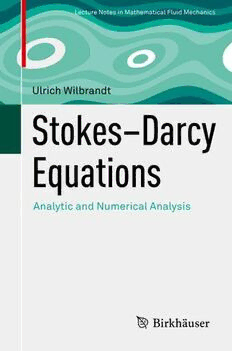
Stokes–Darcy Equations: Analytic and Numerical Analysis PDF
Preview Stokes–Darcy Equations: Analytic and Numerical Analysis
Lecture Notes in Mathematical Fluid Mechanics Ulrich Wilbrandt Stokes–Darcy Equations Analytic and Numerical Analysis Advances in Mathematical Fluid Mechanics Lecture Notes in Mathematical Fluid Mechanics Editor-in-Chief: Galdi,GiovanniP SeriesEditors Bresch,D. John,V. Hieber,M. Kukavica,I. Robinson,J. Shibata,Y. Lecture Notes in Mathematical Fluid Mechanics as a subseries of ‘Advances in Mathematical Fluid Mechanics’ is a forum for the publication of high quality monothematicworkaswelllecturesonanewfieldorpresentationsofanewangle onthemathematicaltheoryoffluidmechanics,withspecialregardstotheNavier- Stokesequationsandothersignificantviscousandinviscidfluidmodels. Inparticular,mathematicalaspectsofcomputationalmethodsandofapplicationsto scienceandengineeringarewelcomeasanimportantpartofthetheoryaswellas worksinrelatedareasofmathematicsthathaveadirectbearingonfluidmechanics. Moreinformationaboutthisseriesathttp://www.springer.com/series/15480 Ulrich Wilbrandt Stokes–Darcy Equations Analytic and Numerical Analysis UlrichWilbrandt WeierstrassInstitute forAppliedAnalysisandStochastics Berlin,Germany ISSN2297-0320 ISSN2297-0339 (electronic) AdvancesinMathematicalFluidMechanics ISSN2510-1374 ISSN2510-1382 (electronic) LectureNotesinMathematicalFluidMechanics ISBN978-3-030-02903-6 ISBN978-3-030-02904-3 (eBook) https://doi.org/10.1007/978-3-030-02904-3 LibraryofCongressControlNumber:2018965415 MathematicsSubjectClassification(2010):46E35,65J10,65N12,76D07,76M10,76S05 ©SpringerNatureSwitzerlandAG2019 Thisworkissubjecttocopyright.AllrightsarereservedbythePublisher,whetherthewholeorpartof thematerialisconcerned,specificallytherightsoftranslation,reprinting,reuseofillustrations,recitation, broadcasting,reproductiononmicrofilmsorinanyotherphysicalway,andtransmissionorinformation storageandretrieval,electronicadaptation,computersoftware,orbysimilarordissimilarmethodology nowknownorhereafterdeveloped. Theuseofgeneraldescriptivenames,registerednames,trademarks,servicemarks,etc.inthispublication doesnotimply,evenintheabsenceofaspecificstatement,thatsuchnamesareexemptfromtherelevant protectivelawsandregulationsandthereforefreeforgeneraluse. Thepublisher,theauthorsandtheeditorsaresafetoassumethattheadviceandinformationinthisbook arebelievedtobetrueandaccurateatthedateofpublication.Neitherthepublishernortheauthorsor theeditorsgiveawarranty,expressorimplied,withrespecttothematerialcontainedhereinorforany errorsoromissionsthatmayhavebeenmade.Thepublisherremainsneutralwithregardtojurisdictional claimsinpublishedmapsandinstitutionalaffiliations. This book is published under the imprint Birkhäuser, www.birkhauser-science.com by the registered companySpringerNatureSwitzerlandAG Theregisteredcompanyaddressis:Gewerbestrasse11,6330Cham,Switzerland Acknowledgements This research would not have been possible without the support of many people. Firstandforemost,IwouldliketoexpressmygreatappreciationtomyadvisorProf. Dr. VolkerJohn forhisconstructivesuggestionsandusefulcritiques.His patience andenthusiasmalwaysservemeasaninvaluableguide. Additionally,IwouldliketothankallthecolleaguesattheWeierstrassInstitute forAppliedAnalysisandStochastics,especiallythemembersoftheresearchgroup “NumericalMathematicsandScientificComputing,”whichIamhappytobeapart of. In particular I wish to acknowledge the help provided by Swetlana Giere and Alfonso Caiazzo, who shared an office with me, as well as Naveed Ahmed, Felix Anker,ClemensBartsch,LauraBlank,JürgenFuhrmann,andTimoStreckenbach. I furthermorewish toexpressmygratitudeto mybelovedfamiliesandfriends, for their understanding and endless love, through the duration of my studies. I am particularlygratefulfor the assistance given by my parents, grandparents,and especiallybymywifeandmydaughterwhomadethisresearchpossible. Thisworkoriginatesfrommydissertationatthe“FreieUniversitätBerlin”which has been handed in 2018. I sincerely thank the reviewers Prof. Dr. Volker John and Prof. Dr. Paul Deuring for their time, as well as very helpful comments and corrections. v Contents 1 Introduction .................................................................. 1 1.1 Motivation .............................................................. 1 1.2 MainContributions..................................................... 2 1.3 Outline.................................................................. 3 1.4 ListofNotations........................................................ 4 2 NotationandPreliminaryResults.......................................... 9 2.1 PreliminariesfromFunctionalAnalysis............................... 9 2.2 SuitableDomains....................................................... 17 2.3 LebesgueSpaces........................................................ 19 2.4 SobolevSpaces......................................................... 21 2.5 LebesgueSpacesontheBoundary .................................... 24 2.6 SobolevSpacesontheBoundary...................................... 25 3 PropertiesofSobolevSpaces................................................ 27 3.1 Mollifications........................................................... 27 3.2 ProductswithSmoothFunctionsandLipschitzTransformations.... 32 3.3 ExtensionfromΩ toRd ............................................... 37 3.4 DensityofSmoothFunctions.......................................... 42 3.5 EquivalentNorms ...................................................... 49 4 Traces.......................................................................... 57 4.1 TheTraceOperator..................................................... 57 4.2 ContinuityoftheTraceOperatoronW1,p(Ω) ....................... 60 4.3 CharacterizationoftheKerneloftheTraceOperator ................ 68 4.4 IntegrationbyParts..................................................... 74 4.5 ARightInverseoftheDivergenceOperator.......................... 75 4.6 EquivalentNormsonH1(Ω).......................................... 78 vii viii Contents 5 SubproblemsIndividually................................................... 83 5.1 LaplaceEquation....................................................... 83 5.2 SaddlePointProblems ................................................. 93 5.3 ApplicationtotheStokesProblem .................................... 99 6 Stokes–DarcyEquations .................................................... 109 6.1 TheSetting.............................................................. 109 6.2 WeakFormulation...................................................... 113 6.3 ExistenceandUniqueness ............................................. 116 6.4 WeakFormulationRewritten .......................................... 119 6.5 LinearOperatorsontheInterface...................................... 127 6.6 Robin–Robin............................................................ 133 6.7 TheFiniteElementMethodfortheStokes–DarcyProblem.......... 148 7 Algorithms.................................................................... 153 7.1 ClassicalIterativeSubdomainMethods............................... 154 7.2 AlgorithmsforInterfaceEquations.................................... 157 7.3 ConvergenceBehavior ................................................. 161 7.4 RemarksontheImplementationandCost ............................ 173 8 NumericalResults............................................................ 175 8.1 GeneralRemarksonNumericalExamples............................ 175 8.2 NumericalExamples................................................... 179 8.3 Computations........................................................... 186 8.4 SummaryandConclusions............................................. 199 A SymbolicComputationstoFindNumericalExamples .................. 201 A.1 VerifyinganExample.................................................. 201 A.2 FindinganExample.................................................... 204 References......................................................................... 207 Index............................................................................... 211 Chapter 1 Introduction 1.1 Motivation Flows in domains which are partly occupied by a porous medium are of great interest and importance,noticeableexamplesinclude groundwater—surfacewater flow, as well as air and oil filters, blood filtration through vessel walls, and fuel cells. Simulations are often characterized by complex geometries and require the solutionoflargesystemsofequations.Forthisreason,efficientsolversareneeded to tackle these types of problems in real-world scenarios. Since the domain of interest is composed of two parts, one allowing a free flow, and one being the porousmatrix,twodifferentmodelsareusedintherespectivesubdomains,namely Stokes and Darcy equations together with suitable coupling conditions on the commoninterface.Theindividualmodelsare wellknownandtailoredsoftwareis available to solve them. The coupled Stokes–Darcy model is somewhat different and it therefore is advisable to find solution strategies which use solutions to the individual models, rather than the coupled one. Inevitably, such strategies are iterative. In this monograph several such approaches are analyzed and their efficiency,especiallywithrespecttothenumberofiterations,isshowntheoretically aswellasnumerically. It turns out that the straightforward definition of such an iterative algorithm alreadyworksverywell, however,only forvaluesof viscosity and hydrauliccon- ductivity which are physically unrealistic. For realistic values, it fails. Alternative schemeshavebeendevelopedbutsufferfromdrawbacksaswell.Therefore,itisan open problemto find algorithmswhich are efficient for a wide range of valuesof viscosityandhydraulicconductivity. Several authorshave studied the Stokes–Darcy coupled system and introduced algorithms which try to solve this problem. The following, while not a complete list,areimportantworksonthissubject:[DQ09,DQV07,CGHW11,JM00,Saf71, + Ang11,CGHW10,CGH 10,GOS11a,LSY02,RY05]. ©SpringerNatureSwitzerlandAG2019 1 U.Wilbrandt,Stokes–DarcyEquations,AdvancesinMathematicalFluidMechanics, https://doi.org/10.1007/978-3-030-02904-3_1 2 1 Introduction The analysis of the schemes introduced in the above mentioned literature considersanL2spaceontheinterface.Inordertodevelopanewalgorithmhowever, the spaces and operators which contribute to the coupling have to be defined and studied in greater detail. It is essential to understandthe notion of traces together with their kernels, image spaces, and existence of (right) inverses. This theory is particularly involved on domains which are not simple, e.g., with non-smooth interfaces. Therefore, a major part of this monograph is devoted to fully develop thistheorywithmanyproofsexplicitlygiven. 1.2 Main Contributions A new kind of Robin–Robin formulation of the coupled Stokes–Darcy problem is analyzed theoretically and numerically. In particular, it is clarified what the smoothnessoftheinterfaceandtheboundaryconditionsadjacenttoitmeanforthe choiceofappropriatespacesinthetwosubdomainsaswellasontheinterfaceitself. TheseincludesubspacesofH1/2whicharerelatedtotheso-calledLions–Magenes spaces and are introduced as the image spaces of suitable trace operators. Since the standard literature concerning the Stokes–Darcy coupling pays little attention to these theoretical details, in this monographmost statements can be found with complete,rigorousproofs. TheuniquenessandexistenceofsolutionsofthecoupledStokes–Darcyproblem in the usual Neumann–Neumannformulationis given and shown to be equivalent to the newly introduced Robin–Robin formulation. Iterative schemes based on the former are analyzed with special focus on the effect of small viscosity and hydraulicconductivity.Theseincludeblock-wiseGauss–Seidel,fixedpoint,aswell as Steklov–Poincaré iterations. In this context, a modified Robin–Robin iteration fromtheliteratureis introduced,analyzed,andcomparedwith iterationsbased on the new Robin–Robin formulation. Specifically, in the discrete setting, a closely related method called D-RR is proposed. All these formulations introduce Robin parameterswhichhavetobechosenappropriately,suchthattheresultingalgorithm is efficient. Even for the algorithms already proposed in the literature, different adviceisgiven.ThenumericalstudiesinChap.8showthatagoodchoiceispossible at least for the D-RR approach,which is thereforesuperior to previously existing approaches in the case of small viscosity and hydraulic conductivity. Thus, this monograph proposes the first subdomain iteration for the coupled Stokes–Darcy problemwhichisapplicableinthepracticallyrelevantcase. The numerical studies support the given analysis for each of the introduced algorithms, using two standard examples from the literature. Finally, an example which is closer to geoscientific applications is considered to study the behavior of the new Robin–Robin iterations with respect to small viscosity and hydraulic conductivity, as well as the Robin parameters, which are introduced with this approach.Thislastexampleisfurthermoreusedtogetanimpressionoftheeffects ofdifferentRobinparametersintermsofthecouplingconditionsontheinterface.
